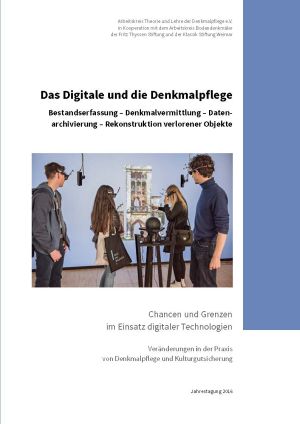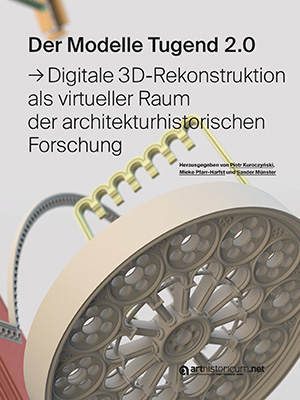Stenzer, Alexander
Das Digitale und die Denkmalpflege: Bestandserfassung – Denkmalvermittlung – Datenarchivierung – Rekonstruktion verlorener Objekte
The ‘digital revolution’ is now in full swing. For heritage conservation, digital tools have opened new perspectives, finding application in the interactive visualization of past situations, the monitoring of threatened sites and artefacts, or the complex cross-referencing of heterogeneous collections of knowledge. At the same time, the limits and unsolved problems associated with using digital technologies are also becoming more apparent, for example with regard to maintaining the rapidly-growing volumes of data being generated.
And yet with digitization, we are not dealing primarily with a ‘technical’ innovation. Thus the effort to conserve digital heritage, including documenting, researching and publishing cultural assets, will transform more than just the institution of the museum. The new abundance of digitally-generated images can also be seen to be changing the standards of the scientific and academic discipline. A further and as yet underappreciated aspect of the digital revolution is the way it is rearranging the foci of attention in the knowledge ‘market’.
Perhaps the most noticeable consequence of digitization’s promise of exact and comprehensive reproduction is the knee-jerk insistence, following every instance of the spectacular destruction of a famous monument, on creating a reconstruction. Here it is clear that an affinity for reconstruction is inherent in the digital, to the extent that its primary feature is its capacity to translate all information into binary code, to capture and copy exactly, supposedly without loss of detail. In the digital age, the distinction between original and copy will therefore lose relevance – at the cost of a total manipulability of data, and of reality.
Konferenzband EVA Berlin 2019. Elektronische Medien & Kunst, Kultur und Historie: 26. Berliner Veranstaltung der internationalen EVA-Serie Electronic Media and Visual Arts
“BASED ON TRUST! Culture in Virtual Environment” is the focus of this year’s conference. It alludes to the oscillating field of tension that has been opened up between data identity and the real presence of cultural heritage. Digital transformation has made available the collection objects in cyberspace. Concerts and performances are transmitted as datastreams, and education and learning is continuously improved by the use of the VR. Digital telepresence technologies, thus, expand the visibility of cultural heritage and generate new contexts, narratives and perspectives.
But how can we represent credibility and uniqueness of the material evidence of the objects in digital data streams? What technical requirements are associated with the creation of plausible and citable scenarios and atmospheres in VR? The claim «Based on Trust» refers to all areas of the «virtualization of the museum» in 2D, 3D, sound and video formats as well as in e-installations, explorative VR applications and AI. Authenticity and credibility are not self-evident at all in digital media. They require complex attribution processes and data curatorial expertise. The Berlin EVA Conference deals with these topics at the interface between memory institutions, public administrations, technology providers and information scientists.
Der Modelle Tugend 2.0: Digitale 3D-Rekonstruktion als virtueller Raum der architekturhistorischen Forschung
The Model Virtue 2.0 - Digital 3D-reconstruction as a virtual space of architectural-historical research understands digital 3D-reconstruction as part of interdisciplinary object-based research. In the guise of a manual, comprehensive methodologies at the interface between archaeology, art and architectural history and computer graphics and cultural informatics are presented and discussed. The central aim of the book is to illustrate the width of the current scientific debate focused on digital 3D reconstructions and to present previous traditions and developments, the current state of research and practice as well as future challenges and desiderata. Students, scientists and interested laypersons will receive a profound overview of the topic of digital 3D reconstruction in the field of architectural history. The work also offers the specialist community a solid basis and thus the point of departure for the identification of future fields of action and suggestions for further debate.









